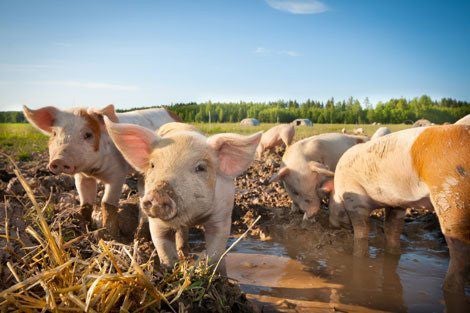From farm animals to family pets, the deadly bacteria may lurk where you least expect it
March 20, 2014—If you think the drug-resistant infectious bacteria MRSA (methicillin-resistant Staphylococcus aureus) is just a hospital or nursing home problem—think again. In recent years the stealth-like bacteria, sometimes simply called “staph,” has expanded from people to animals—ranging from pigs and other farm animals to family pets.
“MRSA is not just a hospital problem anymore. It can affect virtually anyone. It’s changed our thinking of staph strains as species-specific,” Tara Smith, associate professor, Department of Biostatistics, Environmental Health Sciences and Epidemiology, College of Public Health at Kent State University, told a Harvard School of Public Health (HSPH) audience. Smith’s talk, “Pigs, Pork and Pathogens: MRSA in Unexpected Places,” was presented at the Infectious Disease Epidemiology and the Center for Communicable Disease Dynamics Spring Seminar Series on March 6, 2014 in FXB. Dan Larremore, postdoctoral research fellow in the Department of Epidemiology, introduced her.
The CDC reports about one-third of us have staph in our bodies, mostly on our skin or in the nose, but sometimes in the throat or intestinal tract. At least 1.5% or more of the population have the MRSA strain. MRSA may cause no symptoms or just minor skin problems in healthy people, but can lead to life-threatening infections in hospital patients and others with weakened immune systems.
A CDC report last year blamed MRSA for 11,000 deaths and 80,000 infections. Beginning in the late 1990s, a newer “community” form of staph (not the focus of Smith’s talk) was discovered that causes skin and soft tissue problems in schools and gyms, and among wrestlers and others having skin-to-skin contact.
Smith, a specialist in zoonotic infections (those transferred between animals and people), was the first to identify livestock-associated strains of MRSA in the U.S. in 2007. She described her work since then studying MRSA and other staph infections in pigs and other livestock, the farmers who care for the animals, and the farmers’ families. Most of her studies have been done on large commercial farms in Midwestern states and among animals confined to small cages in large industrial buildings.
Twenty years ago scientists believed staph strains did not cross species boundaries, Smith told the audience. But her studies and others have found good reason for MRSA to be a growing concern in veterinary medicine and animal agriculture, as the bacteria has been found in dogs, cats, rabbits, birds, elephants, camels, bats, beavers, lions, fish, and more. “There’s a lot of bidirectional transmission. Animals can pass it to animals. Animals can pass it to humans. Humans can transmit it to pigs,” she said.
Genetic studies have shown that the pig-associated strain of MRSA (ST398) probably originated in humans, then was transmitted to cattle, horses, and other farm animals starting in the mid-1900s. As the farm animals were fed antibiotic-treated food, the animals transmitted MRSA back to people in a drug-resistant form that can be difficult to treat and a challenge to trace.
Smith cited case reported several years ago in the New England Journal of Medicine in which investigators tried to determine the source of a woman’s drug-resistant abscesses. The researchers found she and other family members were colonized with MRSA, but it wasn’t clear until they tested the family cat that they discovered the source—the cat tested positive for MRSA in its throat. The cat and the family members were treated and the woman’s abscesses resolved. “It underscores the importance of thinking about any kind of infection by looking at the family as an entire unit—including people and animals—and not just the human aspects,” Smith said.
Much remains to be learned about MRSA, said Smith. She wants to know if MRSA can be transferred among families whose houses are close together on farms with infected animals and whether consumers are at risk if they handle or eat meat from animals with MRSA. While the bacteria don’t make people sick like salmonella, bringing home contaminated meat does introduce staph into the house for possible colonization.
Smith also wants to explore if MRSA can be spread via the large ventilation fans that keep air moving in the livestock buildings, possibly spreading bacteria from animal waste that is stored below the cages.
“We are trying to figure out how these strains evolve and change,” Smith said. “We’re so focused on the infection part we’re missing the colonization part that could be taking place for decades before we pick it up as clinical infections.”
View the lecture Pigs, Pork and Pathogens: MRSA in Unexpected Places
View schedule for upcoming talks in the lecture series
photo: iStockphoto.com
Learn more
Battling Drug-Resistant Super Bugs (HSPH Forum)
